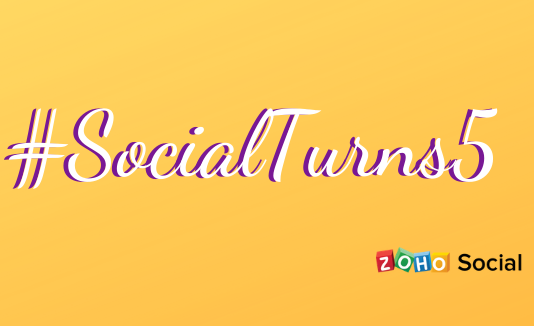- HOME
- Brand Stories
- 5 brands who did emoji campaigns right & what you can learn from them
5 brands who did emoji campaigns right & what you can learn from them
- Last Updated : August 17, 2023
- 23.3K Views
- 6 Min Read

Every day, billions of emoji are being used by us to communicate with each other. Yes, you read that right. Billions. On average, at least 5 billion emoji are being used daily on just a single messenger platform. A significant windfall of this daily emoji usage happens on the platforms we are all too familiar with—social networks. But it’s not just the rest of us. Despite being a bit late to the party, brands too have figured out how emoji can bridge the communication gap and add a zing to their marketing activities.
If you haven’t started using emojis in your marketing yet, you might want to check out our recent article about the basics of emoji marketing and tips to keep in mind before giving it a go. There’s a lot to learn from some of the popular campaigns that have made rounds, in the last few years. Because oftentimes, when brands use emoji creatively to market themselves, it’s only considered “fun,” without much room for real analysis. While some are fun, eye-catching, and even gimmicky at times, there’s definitely a subtext of strategy and planning, and a marketing voice guiding them.
They teach us how to sustain a brand in the ever-crowded social media environment, with the emoji themselves only acting as a medium to achieve it.
So let’s dive into the marketing lessons we’ve learned from some of the most famous emoji campaigns to date.
1. Taco Bell—sell your industry, not just your product
While marketing can only happen through available channels, a smart brand is always pushing the envelope to open new ones. Creating a brand recall is great, but creating an industry recall is truly impressive. Taco Bell didn’t just jump on the bandwagon by releasing a custom emoji to like and re-tweet for “World Taco Day”. No, they took their emoji campaign a step further.
They lobbied the Unicode Consortium for a taco emoji to be made available for Android and iOS. This led to a change.org campaign with thirty-three thousand online signatures and the creation of the taco emoji that now sits on our emoji dashboard today. ?
Taco Bell got themselves in the Emoji Marketing Hall of Fame—we assume that’s a real thing—and managed to create a social media marketing strategy unexplored by other brands. The best part about this? They didn’t just spread the love for Taco Bell, but tacos in general!
2. Domino’s—turning marketing hacks into sales numbers
Remember when Domino’s did this? They let you order pizza by simply tweeting them a pizza emoji. Not only did this fad catch on quickly—because let’s face it, it’s a great idea—it also helped Domino’s increase their online sales by 50% in days after the campaign went live.
While the campaign looks tailored to increase sales and create brand recall, what Domino’s also accomplished here is pretty unique. Even though there was a bit of setup involved—customers had to first set up a Domino’s account, choose their favorite pizza, and then link it to their Twitter—before you tweeted out your first? order, it was still well-received.
This campaign was a good reminder that, while many big-brand marketing campaigns are only about getting clicks and engagement, marketing campaigns that specifically target sales spikes can be just as successful, if done right.
3. World Wide Fund for Nature—making the fun and frivolous more meaningful
It’s not easy to blend two independent strategies together coherently. There’s a reason not all horror comedies work out—it’s not easy to come up with an idea that can straddle diverse tropes well.
But here’s a brand that actually managed to do this really well.
WWF came out with custom-made emojis of endangered animals for a campaign that put them on the map for their marketing smarts. They got netizens to participate in the campaign and agree to donate 11 cents for every time they used one of these 17 emoji—be it a Maui dolphin or a Sumatran Tiger. They’d be directly contributing to the conservation of the specific animal whose emoji they used.
We like this campaign for multiple reasons, and here are just a few:
i. Educated using simple, relatable tools
ii. Raised awareness of a key problem
iii. Reached a wide audience
iv. Allowed anyone to contribute to a cause
If that’s not something to be proud of, we don’t know what is.
4. Deadpool—taking marketing risks

Giant billboards and social media pages carried this banner for days, right around the time the Deadpool movie was set to release worldwide. The emoji-fied banner uses the (dead/poo/L) symbols to spell out the movie’s title.
This was definitely a risky endeavor because it could’ve easily been laughed at and trolled on the internet. But the movie’s marketing strategy was smart about it. They had already branded it as a fun, edgy franchise, and by laughing at themselves, they were able to drive home the tone and vibe of the film’s tongue-in-cheek humor, without seeming like overkill.
5. Sephora—consistency in marketing style
Check out Sephora’s Twitter feed for a minute. We’ll wait.
See what we see?
Within the first few scrolls, you’ll start to notice a pattern. Almost every single post is neatly coordinated with a matching emoji—be it a simple colored heart or a peek into their secret ingredients by throwing in a cucumber or papaya emoji. They’ve sorted out an emoji scheme for every marketing message they put out. From every seasonal campaign to every shade of lipstick, they use emoji to not only build excitement for the product but also show us more about it.
This is a classic case of a brand that’s not just peppering their content with emoji to look hip, but have forged a fun and recognizable voice for themselves. Just by using the marketing tools at hand. While emoji would be a natural fit for the fun, refreshing marketing style Sephora pulls off effortlessly, they’ve made it an integral part of their daily communication and stuck to it consistently. Definitely going on our list of good marketing!
So now that you’ve taken a peek into what these brands really set out to accomplish with these campaigns, here are some deeper lessons from them
a. Find out how emoji can work best with your brand’s persona:
If you have the bandwidth to experiment with different marketing styles, get on it! Most of the brands who have aced in their emoji-centered campaigns tied the emojis they picked back to their product and kept it relevant for all of us. That’s how you avoid being “the one who tried too hard”.
b. Sometimes it’s okay to break emoji rules, as long as you use them creatively:
Look around and see how the internet, especially social media has shaped the meaning of the everyday emoji we use. Would you dare use an eggplant emoji in a conversation? We think not. The flipside to this is that, you can create lasting brand associations to even an everyday emoji—don’t forget to be creative and take measured risks.
c. Being relatable to your audience should be high on your priority list:
It doesn’t matter how great an idea is on its own. If it doesn’t resonate with your audience or suit your brand, follow this sagely marketing advice that has been passed down generations—”junk it!”
d. With smart marketing, nothing is frivolous:
Before you push emoji marketing off the table as a viable social media marketing strategy, remember that any tool is only as frivolous as you allow it to be. Sure, your audience may not be suited for a very informal style of communication, but there’s no harm in jazzing up your social media posts once in a while.
While marketing communication can sometimes get caught up in jargon and fluff, the focus should always be on the message your brand is communicating. Sure tools like emoji are fun to use, but these brands have proven that despite cracking witty ways to brand themselves, it’s the core strategies behind these campaigns that make them memorable, and mention-worthy even today!
 Amruthavarshinii
AmruthavarshiniiChats & writes about anything from social media, culture, to how chai latte isn't a real thing.



Comments(1)
People use emoji to fill out their bare text with colorful accents, use them for emphasis, and crucially to convey emotion and tone. But what about business?